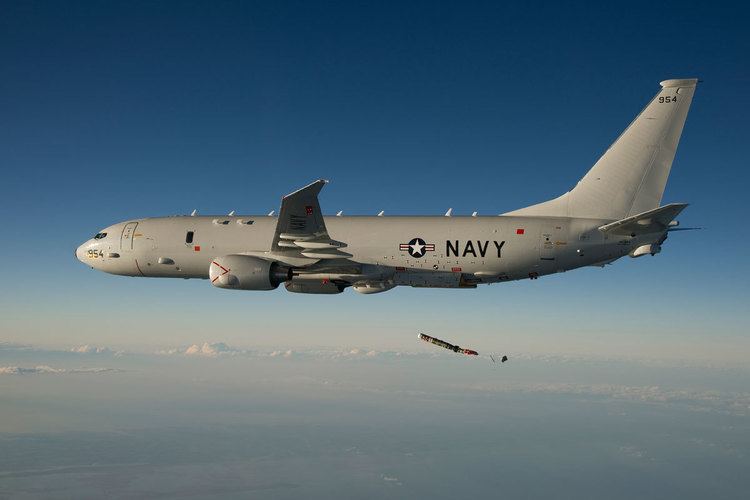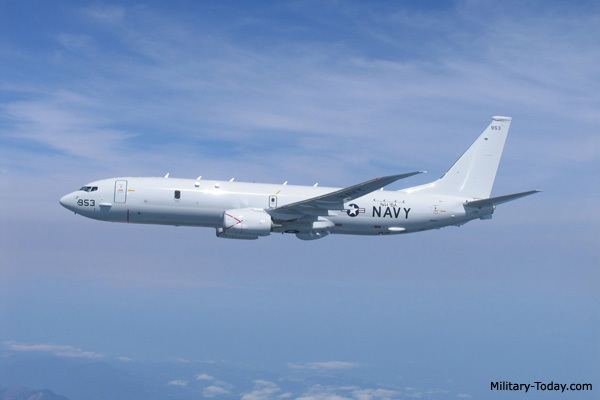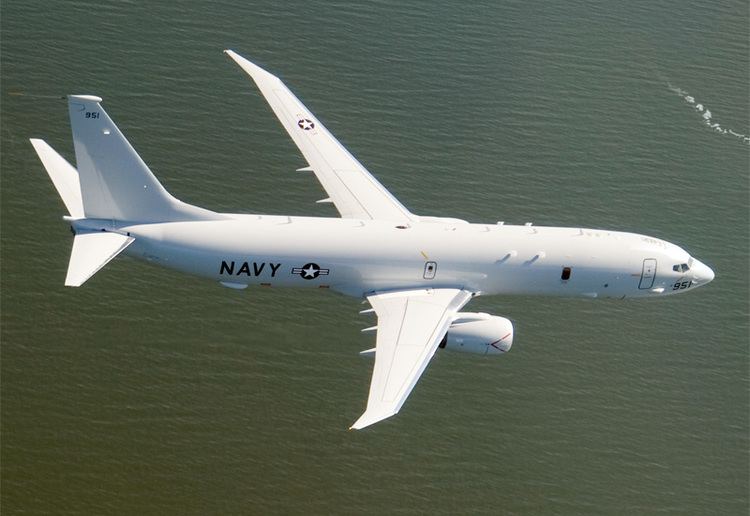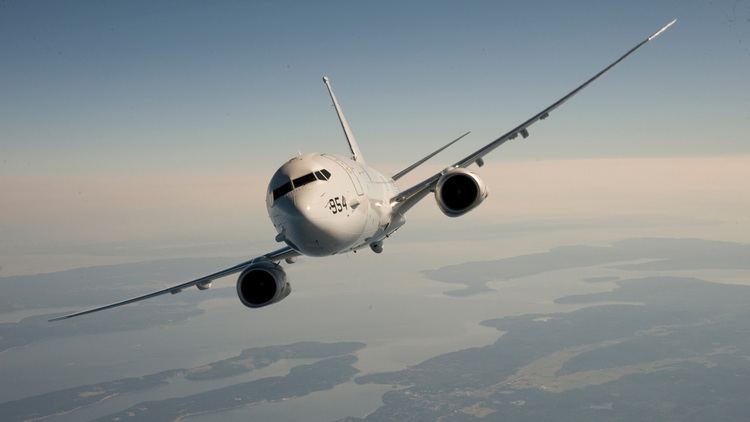Top speed 908 km/h Length 39 m | Range 2,222 km Wingspan 38 m | |
 | ||
Unit cost 201,400,000–275,700,000 USD Manufacturer Boeing Defense, Space & Security | ||
Boeing p 8 poseidon flight demonstration farnborough airshow 2016 tuesday
The Boeing P-8 Poseidon (formerly the Multimission Maritime Aircraft or MMA) is a military aircraft developed for the United States Navy (USN). The aircraft has been developed by Boeing Defense, Space & Security, modified from the 737-800ERX. The P-8 conducts anti-submarine warfare (ASW), anti-surface warfare (ASUW), and shipping interdiction, along with an early warning self protection (EWSP) ability, otherwise known as electronic support measures (ESM). This involves carrying torpedoes, depth charges, Harpoon anti-ship missiles, and other weapons. It is able to drop and monitor sonobuoys. It is designed to operate in conjunction with the Northrop Grumman MQ-4C Triton Broad Area Maritime Surveillance unmanned aerial vehicle.
Contents
- Boeing p 8 poseidon flight demonstration farnborough airshow 2016 tuesday
- Origins
- Design phase and testing
- Derivatives
- Design
- United States
- India
- Australia
- Foreign involvement and potential exports
- United Kingdom
- Norway
- Others
- Variants
- Operators
- Specifications P 8A
- References

The P-8 is operated by the U.S. Navy. The aircraft has been ordered by the Indian Navy as the P-8I Neptune, the Royal Australian Air Force (RAAF), and UK's Royal Air Force (RAF).

Origins

The Lockheed P-3 Orion, a turboprop ASW aircraft, has been in service with the United States Navy since 1962. In the 1980s, the Navy began studies for a P-3 replacement, the range and endurance of which was reducing due to increasing weight and airframe fatigue life limitations. The specification required a new aircraft to have reduced operating and support costs. In 1989, the Navy awarded Lockheed a fixed-price contract to develop the P-7, but this was canceled the following year. A second competition for a replacement began in 2000. Lockheed Martin submitted the Orion 21, an updated new-build version of the P-3. Boeing's proposal was based on its 737-800 airliner. BAE Systems offered a new-build version of the Nimrod MRA4, a British jet-powered maritime patrol aircraft. BAE withdrew from the competition in October 2002, recognizing that without a production partner based in the United States, the bid was politically unrealistic. On 14 May 2004, Boeing was selected as the winner.

In June 2004, the U.S. Navy awarded a development contract to Boeing. The project was planned to be for at least 108 airframes for the Navy. More orders are possible from the other nations operating over 200 P-3s. Project value is expected to be worth at least $15 billion. Raytheon, Northrop Grumman, Spirit AeroSystems, GE Aviation Systems, Marshall Aerospace and Defence Group, CFMI, BAE Systems, and Marotta are major subcontractors. In July 2004, the Navy placed an order for five MMA aircraft, and the first flight-test aircraft was to be completed in 2009. On 30 March 2005, the P-8A designation was assigned to the aircraft.
Design phase and testing

The P-8 is to replace the P-3 Orion. At first, it will be equipped with legacy P-3 systems, but later upgrades will incorporate more advanced technology. The Government Accountability Office credited the incremental approach with keeping the project on schedule and on budget. In 2008, the Naval Air Systems Command (NAVAIR) deleted the requirement for the P-8A to be equipped with magnetic anomaly detection (MAD) equipment as part of an effort that reduced weight by 3,500 lb (1,600 kg) to improve endurance and range. A hydrocarbon sensor detects fuel vapors from diesel-powered submarines and ships.

The P-8's first flight was on 25 April 2009. The second and third P-8s had flown and were in flight testing in early August 2010. On 11 August 2010, the US approved the P-8 for low-rate production. A P-8 released sonobuoys for the first time on 15 October 2010, dropping six sonobuoys in three separate low-altitude passes. In 2011, it was found that the P-8's ice detection system was defective due to the use of counterfeit components; allegedly these computer parts were poorly refurbished and sold to subcontractor BAE Systems as new by a Chinese supplier.
The first production P-8A was handed over to the Navy on 4 March 2012. It flew to Naval Air Station Jacksonville, Florida, for training with the Fleet Replacement Squadron (FRS), Patrol Squadron 30 (VP-30). On 24 September 2012, Boeing announced a $1.9 billion order for 11 aircraft. On 10 June 2013, a DoD Inspector General (IG) report noted that the Navy should delay full-rate production over a lack of key information to assess if the P-8 meets operational requirements. Additional testing was also needed to guarantee a 25-year lifespan. Boeing executives dismissed the report, saying that the test program is on track. In 2013, full-rate production was delayed until the P-8 could demonstrate it can survive its 25-year lifespan without structural fatigue, overcome mission-limited deficiencies, track surface ships, and perform primary missions.
On 24 June 2013, a P-8 successfully scored a direct hit with a live AGM-84D Block IC Harpoon anti-ship missile during weapons integration testing. On 1 July 2013, an initial operational test and evaluation (IOT&E) report found that the P-8A was "operationally effective, operationally suitable, and ready for fleet introduction." Six test and nine low-rate initial production aircraft had been delivered at that point. On 31 July 2013, Boeing received a $2.04 billion contract to build 13 P-8As in the fourth low-rate initial production lot, for a fleet of 37 aircraft by the end of 2016, and long-lead parts for 16 P-8As of the first full-rate production lot.
As of September 2013 it was intended to replace all Navy P-3s with 117 P-8As by 2019, but budget cuts may delay this by two years. On 3 January 2014, the Naval Air Systems Command proceeded with full-rate production of the P-8A. Increment 1 systems include persistent anti-submarine warfare capabilities and an integrated sensor suite; in 2016, Increment 2 upgrades will add multi-static active coherent acoustics, an automated identification system, and high-altitude anti-submarine weapons. Increment 3 in 2020 shall enable "net-enabled anti-surface warfare".
In July 2014, Fred Smith, business development director for the P-8, noted that the program had proved "so efficient, it saved $2.1 billion on 2004 estimates of the cost of production"; and that "the aircraft is now selling for $150 million, down from the forecasted $216 million". The halving of USN orders from 16 aircraft per year down to 8 in 2015 due to the expiration of the Bipartisan Budget Act of 2013 was expected to be partially offset by commercial 737 sales and export sales of the P-8.
Derivatives
In 2010, Boeing proposed to replace the U.S. Air Force's Northrop Grumman E-8 Joint STARS fleet with a modified P-8 at the same cost Northrop Grumman proposed for re-engining and upgrading the E-8s. The proposed P-8 Airborne Ground Surveillance (AGS) would integrate an active electronically scanned array (AESA) radar, and have ground moving target indicator (GMTI) and synthetic aperture radar (SAR) capabilities.
The main distinguishing feature of the P-8 AGS was a pod-mounted radar on the lower centerline of the fuselage; the pod is lowered so the engine nacelles do not interrupt the radar's line of sight. Two aft ventral fins increase aircraft stability. The P-8 AGS reused the P-8A's Raytheon AN/APY-10 multi-mission surface search radar. In 2010, the Air Force launched an Analysis of Alternatives (AoA) of the JSTARS platform. In 2013, Boeing proposed repackaging P-8 systems in the smaller and less expensive Bombardier Challenger 600 series business jet, as the Boeing Maritime Surveillance Aircraft (MSA), instead. In 2014, Boeing also offered a JSTARS replacement based on the Boeing 737-700, rather than the P-8's 737-800.
Design
The P-8 is a militarized version of the 737-800ERX, a 737-800 with 737-900-based wings. The fuselage is similar, but longer, than the 737-700-based C-40 Clipper transport aircraft in service with the U.S. Navy. The P-8 has a strengthened fuselage for low-altitude operations and Boeing 767-400ER-style raked wingtips, instead of the blended winglets available on 737NG variants. In order to power additional onboard electronics, the P-8 has a 180kVA electric generator on each engine, replacing the 90kVA generator of civilian 737s; this required the redesigning of the nacelles and their wing mountings. The P-8 has a smoother flight experience, subjecting crews to less turbulence and fumes than the preceding P-3, allowing them to focus better on missions.
The five operator stations (two naval flight officers plus three enlisted Aviation Warfare Operators/naval aircrewman) are mounted in a sideways row, along the port side of the cabin. None of the crew stations have windows; a single observer window is located on each side of the forward cabin. A short bomb bay for torpedoes and other stores opens behind the wing. The P-8 is to be equipped with the High Altitude Anti-Submarine Warfare Weapon Capability (HAAWC) Air Launch Accessory (ALA), turning a Mark 54 torpedo into a glide bomb for deploying from up to 30,000 ft (9,100 m).
The P-8 features the Raytheon APY-10 multi-mission surface search radar; the P-8I features an international version of the APY-10. Unlike the preceding P-3, the P-8 lacks a magnetic anomaly detector (MAD) due to its higher operational altitude; its acoustic sensor system is reportedly more effective at acoustic tracking and thus lacking a MAD won't impede its detection capabilities; India's P-8I is equipped with a MAD per the contract request. Various sensor data are combined via data fusion software to track targets. Following the cancellation of Lockheed Martin's Aerial Common Sensor project, Boeing proposed a signals intelligence variant of the P-8 for the Navy's requirement. During the P-8A Increment 2 upgrade in 2016, the APS-149 Littoral Surveillance Radar System (LSRS) will be replaced by the Advanced Airborne Sensor radar.
In U.S. service, the P-8 fleet will be complemented by around 40 MQ-4C Triton unmanned aerial vehicles (UAVs) for the Broad Area Maritime Surveillance system to provide continuous surveillance. In January 2015, BAE Systems was awarded a contract for the Navy's High Altitude ASW (HAASW) Unmanned Targeting Air System (UTAS) program to develop a sub-hunting UAV equipped with a MAD for launching from the P-8. The P-8 cannot use the Navy's typical hose-and-drogue in-flight refueling method, instead featuring a flying boom receptacle on the upper-forward fuselage. For extended endurance, six additional fuel tanks from Marshall Aerospace are housed in the forward and rear cargo compartments.
United States
In February 2012, the P-8 made its mission debut during "Bold Alligator" 2012, an annual littoral warfare exercise. In April 2012, it took part in Exercise Joint Warrior, flying out of RAF Lossiemouth. During RIMPAC 2012 in the Hawaiian area, two P-8As participated in 24 scenarios as part of Air Test and Evaluation Squadron One (VX-1) while forward deployed to Marine Corps Base Hawaii. On 29 November 2013, the P-8's inaugural deployment began when six aircraft and 12 air crews of squadron VP-16 departed its home station of NAS Jacksonville, Florida, for Kadena Air Base in Okinawa, Japan. This forward deployment with the U.S. Pacific Fleet was pre-planned as part of a regional re-balance, but occurred shortly after China's establishment of the East China Sea Air Defense Identification Zone, heightening tensions.
During exercises in 2012 and 2013, and an overseas deployment to Japan, the P-8 reportedly exhibited radar, sensor integration, and data transfer problems, leading to additional testing. In January 2014, the Pentagon's Director of Operational Test and Evaluation office called the P-8A "ineffective" for large area ISR and anti-submarine warfare missions, and said that the initial aircraft were not ready for deployment. The same report found that the P-8 was effective at the small-area search mission, and with much better range, speed, and reliability than older aircraft. Pentagon acquisition undersecretary Frank Kendall disputed the report, saying that although its findings are factual, it did not acknowledge future capability upgrades for anti-submarine and wider-area surveillance.
A second squadron, VP-5, completed its transition to the P-8 in August 2013 with its next overseas deployment slated for mid-2014. A third squadron, VP-45, began its transition to the Poseidon in July 2013. During mid-2014, a pair of P-8s were dispatched to Perth, Australia for two months as part of an international search for the missing Malaysia Airlines Flight 370. USN P-8s may routinely rotate through bases of allies. In September 2014, Malaysia offered the use of bases in Borneo for P-8s, but no flights have yet been approved.
On 19 August 2014, a Chinese J-11 fighter came within 30 feet of a P-8 around 135 miles east of Hainan Island. The J-11 flew past the P-8's nose and performed a barrel roll at close proximity. A Pentagon spokesperson said the J-11's unit had made close intercepts earlier that year. The U.S. sent a diplomatic note to China about the pattern of behavior by the commander of the Chinese fighter group. China stated that the claims were "totally groundless", and that the event's root was U.S. surveillance of China; the U.S. stated it will continue to operate in international airspace and waters.
On 7 December 2015, P-8s were deployed to Singapore to monitor the Southeast Asia region as part of a Defense Cooperation Agreement signed by the US and Singapore to enhance "cooperation between the two countries in fighting terrorism and piracy." China criticized the basing of P-8s in Singapore as "regional militarization by the U.S." The third detachment of two P-8s based in Paya Lebar Air Base, Singapore are involved in naval military drills conducted with the Singapore Armed Forces (SAF) in July–August 2016.
India
In January 2008, Boeing proposed the P-8I, a customized export variant of the P-8A, for the Indian Navy. It features two major components not fitted on the P-8A, a Telephonics APS-143 OceanEye aft radar and a magnetic anomaly detector (MAD). On 4 January 2009, India's Ministry of Defence signed a US$2.1 billion agreement with Boeing for the supply of eight P-8Is to replace the Indian Navy's aging Tupolev Tu-142M maritime surveillance turboprops. India was the P-8's first international customer and was also Boeing's first military sale to India. In October 2010, India's Defence Acquisition Council approved the purchase of four additional P-8Is; this purchase is reportedly under consideration as of 2014. In 2011, India planned to order 12 more P-8Is at a later date. In July 2016, it was confirmed India had ordered another four P-8Is that will be delivered by 2020.
The Bharat Electronics Limited (BEL) Data Link II communications allows the P-8I to exchange tactical data between Indian Navy aircraft, ships and shore establishments. The P-8I features an integrated BEL-developed IFF system. India has purchased AGM-84L Harpoon Block II Missiles and Mk 54 All-Up-Round Lightweight Torpedoes for the P-8I. In July 2012, Boeing began flight testing of the P-8I. On 19 December 2012, the first P-8I was handed over to an Indian naval team at Boeing's Seattle facility. The Indian Navy inducted its first P-8I on 15 May 2013. The second and third P-8Is were received on 16 and 22 November 2013 respectively. The aircraft are based at INS Rajali, in Tamil Nadu. In 2014, several Indian Navy P-8Is conducted search operations for the missing Malaysia Airlines Flight 370. The fourth, fifth and sixth aircraft was delivered in May, September and November 2014 respectively. The seventh and eight aircraft were delivered in February and November 2015 respectively. Indian Navy inducted the first squadron in November 2015.
Australia
On 20 July 2007, the Australian Minister for Defence announced selection of the P-8A MMA as the preferred aircraft to replace the Royal Australian Air Force fleet of Lockheed AP-3C Orions in conjunction with a yet-to-be-selected unmanned aerial vehicle. The last AP-3C is scheduled to be retired in 2018, after nearly 30 years of service. In March 2009, Australia's Chief of Air Force stated that subject to government approval, the RAAF would begin to introduce the P-8 in 2016. In October 2012, Australia formalized its participation with a commitment of A$73.9m (US$81.1m) in an agreement with the USN. In July 2013, Air Marshal Geoff Brown, head of the RAAF, said Australia was considering purchasing more P-8s and fewer MQ-4C Triton UAVs than earlier planned. On 21 February 2014, Prime Minister Tony Abbott announced Australia's intention to procure eight P-8s plus options for four more; entry into service is planned for 2021.
In July 2014, negotiations commenced between Boeing and the Department of Defense for integration of the AGM-84 Harpoon Block 1G anti-ship missile onto the P-8A on behalf of Australia, which is reportedly a matter of interfacing with the aircraft's combat system software. In August 2014, the US Navy had reportedly concluded an advanced acquisition contract on the first four of up to 12 P-8As to be purchased by Australia, with delivery expected from 2017. Boeing confirmed that "production of the first Australian P-8A will begin later in 2015, with delivery to the RAAF scheduled for 2016." In January 2016, Australia ordered a further four P-8s. The 2016 Defence White Paper stated that eight P-8s would be in service in early 2020s and that 15 P-8s are planned to be in service by the late 2020s. On 19 July 2016, the US DoD announced Boeing's award of a $100 million contract for the next tranche of four P-8As, with completion projected for June 2017. Including support facilities, the first tranche of eight aircraft's total cost is estimated at $3.6 billion (AU$4 billion).
The RAAF accepted its first P-8 on 27 September 2016; it arrived in Australia on 14 November.
Foreign involvement and potential exports
The U.S. Department of Defense wants to follow a program template for the P-8 similar to that of the Lockheed Martin F-35 Lightning II Joint Strike Fighter (JSF) program, with international cooperation from prospective MMA users.
United Kingdom
In August 2012, it was reported that Boeing saw the United Kingdom as a market for the P-8, following the cancellation of Nimrod MRA4. On 23 November 2015, the UK announced its intention to order nine P-8 aircraft as part of the Strategic Defence and Security Review 2015. The aircraft are to be based at RAF Lossiemouth, Scotland and be used to protect the UK's nuclear deterrent and new aircraft carriers, as well as to perform search-and-rescue and overland reconnaissance missions.
On 25 March 2016, the U.S. State Department approved a proposed Foreign Military Sale to the UK for up to nine P-8 aircraft and associated support, at an estimated cost of $3.2 billion. The Royal Air Force plans to operate the P-8 with U.S. weapons initially, and possibly transition to British weapons later. It is unclear whether the UK will have access to future ground-surveillance capabilities developed for the P-8. On 11 July 2016, Boeing announced that the signing of a procurement contract with the Royal Air Force for nine P-8 aircraft and support infrastructure at a cost of $3.87 billion (£3 billion). Manufacture will be spread across three production lots over a ten-year period, with deliveries commencing in 2019.
Norway
In March 2014, Norwegian newspaper Dagbladet reported that the Norwegian Navy is looking at possibly leasing the aircraft from Boeing. The Navy has six P-3 Orions and is having increasing difficulty keeping them operational. In June 2016, Norwegian newspaper Verdens Gang reported that the Norwegian government has in its long-term plan for Norwegian defense will buy four new surveillance aircraft. The government did not mention a specific aircraft type, but the main option is the P-8 Poseidon. In November 2016, it was reported that Norway plans to order five P-8s to replace its aging P-3s.
Others
Italy indicated interest in purchasing MMA aircraft, with fleet support provided by Alitalia in 2004. However, in December 2008, Italy announced the purchase of four ATR 72 turboprop aircraft to replace its aging Atlantic Maritime Patrol Aircraft, possibly as a temporary solution because Italy remained interested in the P-8.
Boeing publicly identified Royal New Zealand Air Force as a potential customer in 2011. The P-8 would replace its fleet of P-3 Orions which are due for replacement in 2025.
Turkey indicated that it is planning to acquire a new MMA aircraft to supplement existing aircraft with the P-8A being the main candidate based on the required operational performance.
Boeing identified that the Royal Canadian Air Force's fleet of 18 CP-140 Aurora aircraft (Canadian variant of the P-3 Orion) would begin to reach the end of their service life by 2025. Boeing offered the Challenger MSA, a smaller and cheaper aircraft based on the Bombardier Challenger 650 that integrates many of the same sensors and equipment from the P-8, to complement Canada's CP-140 Aurora fleet as older aircraft were retired, but not to directly replace the Auroras. Boeing's Aurora replacement aircraft offer would instead be the P-8A Poseidon with additional modifications specific to Canadian operations.
Variants
Operators
Specifications (P-8A)
Data from U.S. Navy, Boeing, and others
General characteristics
Performance
Armament
Avionics
